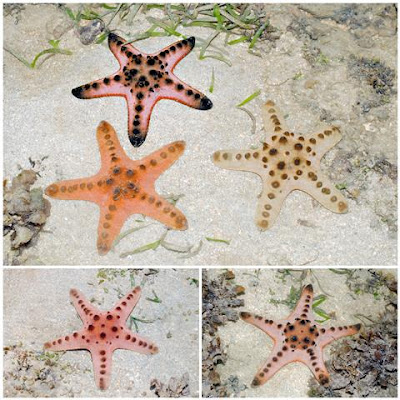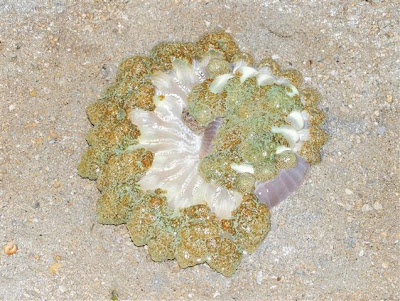We celebrated Singapore's 48th birthday at Pulau Semakau on National Day! And it was an awesome field trip because of the many spectacular finds.
The top find of the day (at least for me) would definitely be the Galloping sea star (Stellaster equistris) that has only been sighted here and Sentosa. This was the top of my wish list... thank you Pei Yan for finding it so quickly after we landed on the shore.
This sea star has an underside that is probably prettier than its upper side. It is in white with some rounded patterns near its mouth.
There are many Common sea stars (Archaster typicus) on Semakau and this particular one has only four arms. Can you also spot the many tiny gobies swimming around?
Ria found a new sea star record for Semakau! This Astropecten sea star has been sighted twice at Changi East and we also just saw it the day before at Cyrene. It is really huge as it is slightly bigger than my palm.
The underside is stunning as this sea star has bright orange tube feet that lines up the entire underside of its arms. For this sea star, you can actually tell that there are segments that have been regenerated based on the different colours along the length of each arm.
A pleasant surprise on the reefy parts of the shore would be these Knobbly sea stars (Protoreaster nodosus). It is my first time seeing them at this stretch of Semakau.
We found a Laganum sand dollar (Laganum depressum) that has also been sighted here before.
Among the seagrass blades, I saw this fat and long Synaptic sea cucumbers that has banded patterns on its body.
Though the soft parts of this shore resembles Chek Jawa, the presence of rocks actually allow many of these Giant carpet anemones (Stichodactyla gigantea) to be anchored on. These carpet anemones are abundant on this part of Semakau.
I also came across two of these Fire anemones (Actinodendron sp.) where this particular anemone has its tentacles well extended out.
Whereas, this other anemone has half of its tentacles brought close to its mouth. I have no idea why they tend to do that though.
Resembling anemones, these are actually Upsidedown jellyfish (Cassiopea sp.) that prefers to be upside down because they harbour microalgae on their tentacles to photosynthesize.
The Green penaeid prawn (Family Penaeidae) is very well camouflaged with the green from seagrass and seaweed. If not for its movement, I wouldn't be able to spot it.
Marcus found a snake! This is the Dog-faced water snake (Cerberus rynchops) that can be found near mangroves. It is not surprise to find this snake as the shore is right beside the regenerated mangroves.
This snake is quite docile and shy and thus we were able to take close up shots of its "dog-face".
Chay Hoon found a special crab! This tiny bright orange crab is the Masked burrowing crab (Gomeza sp.) and as its name suggests, it can burrow very quickly into the sand.
Checking out the reefier parts briefly, I came across a good range of hard corals near the reef edge.
This particular "coral" or something looks strange to me. It is bright green and is encrusted onto the rubble surface. Is it a coral or something else altogether?
Only one slug was sighted and it is the Polka-dot jorunna nudibranch (Jorunna funebris).
As the sun peeks out from the seawall, I went closer to have a look at what lies on this part of the shore.
Unfortunately, there was a long driftnet laid from the end of a seawall towards where it nearly meets the seawater. And there were many animals trapped such as the horseshoe crabs and stingrays.
Here's another pair of horseshoe crabs trapped and entangled by the net. There were simply too many of them to be rescued.
The saddest part was to see three dead black-tipped reef sharks lying near the line.
Here's the first one...
second one...
and the third one....
Before the start of the trip, we saw a person holding torch light in the dark on the shore near where the driftnet was laid. However much later, this person went up the seawall and disappeared.
Do read more about Ria's thought on this drift net on the Project Driftnet blog: http://projectdriftnet.blogspot.sg/2013/08/driftnet-traps-sharks-horseshoe-crabs.html
It is sad to see many of these animals trapped and left alone to die because they probably are not wanted by the person who laid the drift net.

































No comments:
Post a Comment